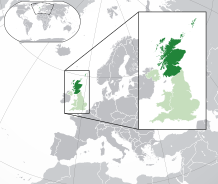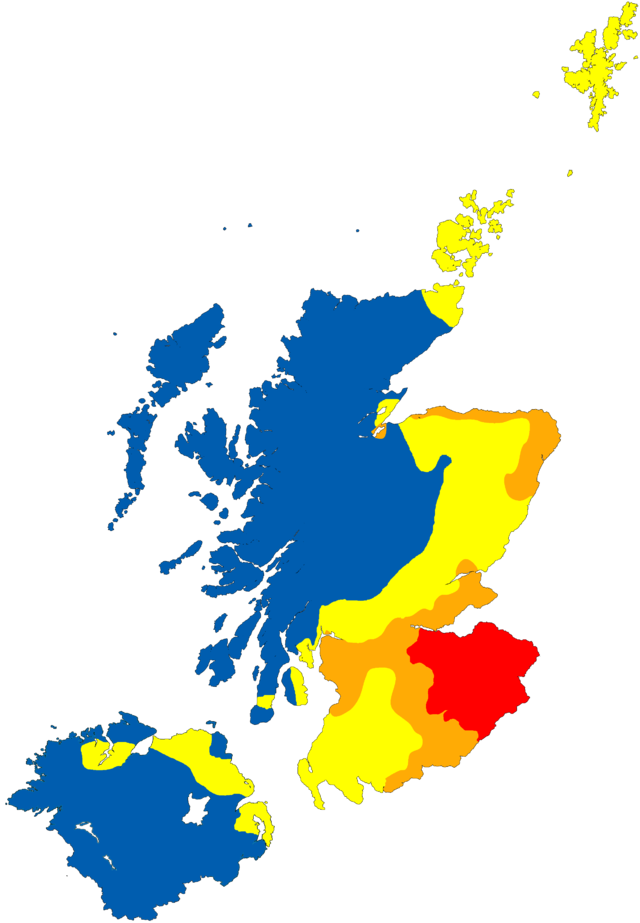Portal:Scotland
Wikipedia portal for content related to Scotland / From Wikipedia, the free encyclopedia
Portal maintenance status: (July 2018)
|
| Main Page | Selected articles 1 | Selected articles 2 | Selected biographies | Selected quotes | Selected pictures | Featured Content | Categories & Topics |
Introduction
 |
 |
|
 | ||
Scotland (Scots: Scotland; Scottish Gaelic: Alba) is a country that is part of the United Kingdom. It contains nearly one-third of the United Kingdom's land area, consisting of the northern part of the island of Great Britain and more than 790 adjacent islands, principally in the archipelagos of the Hebrides and the Northern Isles. To the south-east, Scotland has its only land border, which is 96 miles (154 km) long and shared with England; the country is surrounded by the Atlantic Ocean to the north and west, the North Sea to the north-east and east, and the Irish Sea to the south. The population in 2022 was 5,439,842 and accounts for 8% of the population of the UK. Edinburgh is the capital and Glasgow is the largest of the cities of Scotland.
The Kingdom of Scotland emerged as an independent sovereign state in the 9th century. In 1603, James VI inherited the Kingdom of England and the Kingdom of Ireland, forming a personal union of the three kingdoms. On 1 May 1707 Scotland and England combined to create the new Kingdom of Great Britain, with the Parliament of Scotland subsumed into the Parliament of Great Britain. In 1999 a Scottish Parliament was re-established, and has devolved authority over many areas of domestic policy. The country has a distinct legal system, educational system, and religious history from the rest of the UK, which have all contributed to the continuation of Scottish culture and national identity. Scottish English and Scots are the most widely spoken languages in the country, existing on a dialect continuum with each other. Scottish Gaelic speakers can be found all over Scotland, however the language is largely spoken natively by communities within the Hebrides. The number of Gaelic speakers numbers less than 2% of the total population, though state-sponsored revitalisation attempts have led to a growing community of second language speakers.
The mainland of Scotland is broadly divided into three regions: the Highlands, a mountainous region in the north and north-west; the Lowlands, a flatter plain across the centre of the country; and the Southern Uplands, a hilly region along the southern border. The Highlands are the most mountainous region of the British Isles and contain its highest peak, Ben Nevis, at 4,413 feet (1,345 m). The region also contains many lakes, called lochs; the term is also applied to the many saltwater inlets along the country's deeply indented western coastline. The geography of the many islands is varied. Some, such as Mull and Skye, are noted for their mountainous terrain, while the likes of Tiree and Coll are much flatter. (Full article...)
Selected article

Scots is an Anglic language variety in the West Germanic language family, spoken in Scotland and parts of Ulster in the north of Ireland (where the local dialect is known as Ulster Scots). Most commonly spoken in the Scottish Lowlands, Northern Isles, and northern Ulster, it is sometimes called Lowland Scots to distinguish it from Scottish Gaelic, the Goidelic Celtic language that was historically restricted to most of the Scottish Highlands, the Hebrides, and Galloway after the sixteenth century; or Broad Scots to distinguish it from Scottish Standard English. Modern Scots is a sister language of Modern English, as the two diverged independently from the same source: Early Middle English (1150–1300).
Scots is recognised as an indigenous language of Scotland by the Scottish government, a regional or minority language of Europe, and a vulnerable language by UNESCO. In a Scottish census from 2022, over 1.5 million people in Scotland reported being able to speak Scots.
Given that there are no universally accepted criteria for distinguishing a language from a dialect, scholars and other interested parties often disagree about the linguistic, historical and social status of Scots, particularly its relationship to English. Although a number of paradigms for distinguishing between languages and dialects exist, they often render contradictory results. Broad Scots is at one end of a bipolar linguistic continuum, with Scottish Standard English at the other. Scots is sometimes regarded as a variety of English, though it has its own distinct dialects; other scholars treat Scots as a distinct Germanic language, in the way that Norwegian is closely linked to but distinct from Danish.
Selected quotes
" ... There are only two types of music: rock and roll ... "
" ... A man willing to work, and unable to find work, is perhaps the saddest sight that Fortune's inequality exhibits under this sun ... "
In the news

- 24 July 2024 –
- Researchers from the Scottish Association for Marine Science report evidence of dark oxygen being produced from metals on the seafloor. It was previously assumed that almost all the free oxygen (O
2) on Earth was created through photosynthesis, which requires sunlight. (NPR) - 24 June 2024 –
- The Royal Zoological Society of Scotland reports that Scottish wildcat kittens have been born in the Cairngorms National Park, in a "major milestone" for the conservation of the critically endangered population. (The Guardian)
- 7 May 2024 – Premiership of John Swinney
- The Scottish Parliament votes to elect John Swinney as First Minister of Scotland with 64 votes in favour and seven abstentions from the Scottish Greens. (BBC News)
- 6 May 2024 – 2024 Scottish National Party leadership election
- John Swinney is elected leader of the Scottish National Party following the resignation of First Minister Humza Yousaf. (The Guardian)
- 4 May 2024 – International reactions to the Israel–Hamas war
- Palestinian doctor and rector at the University of Glasgow Ghassan Abu-Sittah is denied entry into France after landing at Charles de Gaulle airport on his way to speak at the French Senate. Last month, he was denied entry into Germany. (Al Jazeera)
- 1 May 2024 – 2024 Scottish government crisis
- The Scottish National Party administration survives the vote of no confidence earlier this week, prompting the party to seek a replacement for outgoing First Minister Humza Yousaf. (Al Jazeera)
Selected biography

Sir William Connolly CBE (born 24 November 1942) is a Scottish retired comedian, actor, artist, musician, and television presenter. He is sometimes known by the Scots nickname the Big Yin ("the Big One"). Known for his idiosyncratic and often improvised observational comedy, frequently including strong language, Connolly has topped many UK polls as the greatest stand-up comedian of all time. In 2022 he received the BAFTA Fellowship for lifetime achievement from the British Academy of Film and Television Arts.
Connolly's trade, in the early 1960s, was that of a welder (specifically a boilermaker) in the Glasgow shipyards, but he gave it up towards the end of the decade to pursue a career as a folk singer. He first sang in the folk rock band The Humblebums with Gerry Rafferty and Tam Harvey, with whom he stayed until 1971, before beginning singing as a solo artist. In the early 1970s, Connolly made the transition from folk singer with a comedic persona to fully-fledged comedian, for which he is now best known. In 1972, he made his theatrical debut, at the Cottage Theatre in Cumbernauld, with a revue called Connolly's Glasgow Flourish. He also played the Edinburgh Festival Fringe. In 1972, Connolly's first solo album, Billy Connolly Live!, was produced, with a mixture of comedic songs and short monologues. In 1975 he topped the UK Singles Chart with "D.I.V.O.R.C.E."
As an actor, Connolly has appeared in various films, including Water (1985), Indecent Proposal (1993), Pocahontas (1995), Muppet Treasure Island (1996), Mrs Brown (1997) (for which he was nominated for the BAFTA Award for Best Actor in a Leading Role), The Boondock Saints (1999), The Last Samurai (2003), Lemony Snicket's A Series of Unfortunate Events (2004), The X-Files: I Want to Believe (2008), Brave (2012), and The Hobbit: The Battle of the Five Armies (2014). On his 75th birthday in 2017, three portraits of Connolly were made by leading artists Jack Vettriano, John Byrne, and Rachel Maclean. These were later turned into part of Glasgow's official mural trail. In October that year, he was knighted at Buckingham Palace by Prince William, for services to entertainment and charity.
Selected picture
The Cuillin (Scottish Gaelic: An Cuilthionn (or An Cuiltheann)) are properly and locally known as The Cuillins in the plural, and are a range of rocky mountains located on the Isle of Skye. The true Cuillin is also known as the Black Cuillin to distinguish it from the Red Hills (na Beanntan Dearga) across Glen Sligachan.
Photo credit: Andrewmckie
Did You Know...

- ... that because of violent reactions – such as Jenny Geddes's on 23 July 1637 – to a Scottish prayer book, Walter Whitford kept loaded pistols visible to his congregants while using the book?
- ... that background research for Dujanah included interviews with Muslim apostates and a Scottish veteran of Afghanistan?
- ... that William of Littlington opposed the division of England and Scotland into two Carmelite provinces in 1303, was excommunicated, and did four years' penance in Paris?
- ... that the 2024 Hillhead by-election was the first by-election won by the Scottish Green Party?
- ... that Ian Begg, known for his work on restoration of castles in Scotland, designed and built his own 20th-century tower house to live in?
- ... that the 1830 abandonment of Chipewyan woman Matooskie by her Scottish husband was eventually settled with a dowry payment of £200?
- ... that Grey Gowrie, while holding office under Margaret Thatcher, described himself as "Irishman with a Scots name and a German wife, working, somewhat to his surprise, for a very English government"?
- ... that despite his defeat at the battle of Pitgaveny, both of Duncan's sons would later rule Scotland?
Get involved
For editor resources and to collaborate with other editors on improving Wikipedia's Scotland-related articles, see WikiProject Scotland.
To get involved in helping to improve Wikipedia's Scotland related content, please consider doing some of the following tasks or joining one or more of the associated Wikiprojects:
- Visit the Scottish Wikipedians' notice board and help to write new Scotland-related articles, and expand and improve existing ones.
- Visit Wikipedia:WikiProject Scotland/Assessment, and help out by assessing unrated Scottish articles.
- Add the Project Banner to Scottish articles around Wikipedia.
- Participate in WikiProject Scotland's Peer Review, including responding to PR requests and nominating Scottish articles.
- Help nominate and select new content for the Scotland portal.
Do you have a question about The Scotland Portal that you can't find the answer to?
Post a question on the Talk Page or consider asking it at the Wikipedia reference desk.
Related portals
Other language versions
Associated Wikimedia
The following Wikimedia Foundation sister projects provide more on this subject:
-
Commons
Free media repository -
Wikibooks
Free textbooks and manuals -
Wikidata
Free knowledge base -
Wikinews
Free-content news -
Wikiquote
Collection of quotations -
Wikisource
Free-content library -
Wikispecies
Directory of species -
Wikiversity
Free learning tools -
Wikivoyage
Free travel guide -
Wiktionary
Dictionary and thesaurus






































